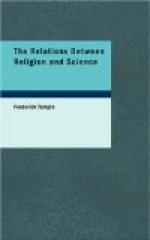The fact is that the doctrine of Evolution does not affect the substance of Paley’s argument at all. The marks of design which he has pointed out remain marks of design still even if we accept the doctrine of Evolution to the full. What is touched by this doctrine is not the evidence of design but the mode in which the design was executed. Paley, no doubt, wrote on the supposition (and at that time it was hardly possible to admit any other supposition) that we must take animals to have come into existence very nearly such as we now know them: and his language, on the whole, was adapted to that supposition. But the language would rather need supplementing than changing to make it applicable to the supposition that animals were formed by Evolution. In the one case the execution follows the design by the effect of a direct act of creation; in the other case the design is worked out by a slow process. In the one case the Creator made the animals at once such as they now are; in the other case He impressed on certain particles of matter which, either at the beginning or at some point in the history of His creation He endowed with life, such inherent powers that in the ordinary course of time living creatures such as the present were developed. The creative power remains the same in either case; the design with which that creative power was exercised remains the same. He did not make the things, we may say; no, but He made them make themselves. And surely this rather adds than withdraws force from the great argument. It seems in itself something more majestic, something more befitting Him to Whom a thousand years are as one day and one day as a thousand years, thus to impress




